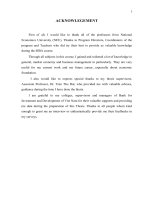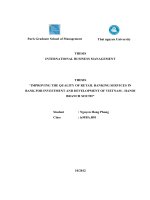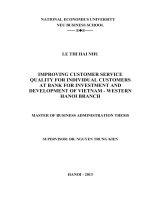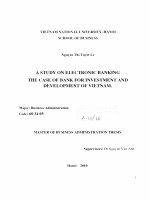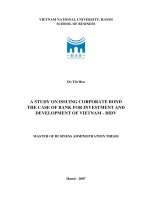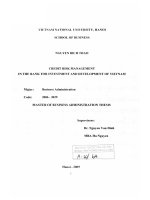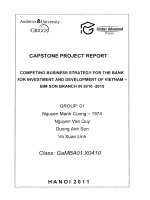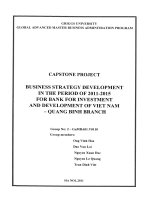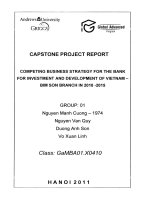Exploring factors affecting employee job satisfaction at bank for investment and development of viet nam
Bạn đang xem bản rút gọn của tài liệu. Xem và tải ngay bản đầy đủ của tài liệu tại đây (508.62 KB, 53 trang )
RESEARCH PROJECT
(BMBR5103)
EXPLORING FACTORS AFFECTING EMPLOYEE
JOB SATISFACTION AT
BANK FOR INVESTMENT
AND DEVELOPMENT OF VIETNAM
STUDENT’S FULL NAME : NGUYEN PHUONG NAM
STUDENT ID : 14967
INTAKE : MARCH 2013
ADVISOR’S NAME & TITLE : NGUYEN THE KHAI, DBA
SEPTEMBER 2014
Page iii of 53
ADVISOR’S COMMENTS
Advisor’s signature:
Page iv of 53
DECLARATION
I declare that the work on which this dissertation is based, hereby submitted to Open
University Malaysia for the degree of Master of Business Administration. This wok has not
previously been submitted by me for a degree at this or any other university. It is my work in
design and execution, and that all material contained herein has been duly acknowledged.
Nguyen Phuong Nam (Mr.)
Page v of 53
ACKNOWLEDGEMENTS
Firstly, I came to my great pleasure to have a chance to attend the official course of
Strategic Management of OUM and HUTECH conducted by Nguyen The Khai, DBA two months
ago. Through this class, a lot of knowledge on Business Research Method with different angles,
art and skills needed have been absorbed carefully and this will help me a lot in the long run to
work in business environment.
Secondly, understanding of Business Research Method will help me and other members of
the class build teamwork’s environment, leading team and motivate others through Business
Research Method.
Thirdly, I would like to express my great thankfulness to my lecturer – Nguyen The
Khai, DBA, who inspired me with interesting lessons, ways of systematic learning that will be
very useful for me.
With kind regards,
Nguyen Phuong Nam
Page vi of 53
Contents
ADVISOR’S COMMENTS iii
DECLARATION iv
ACKNOWLEDGEMENTS v
LIST OF TABLES ix
LIST OF FIGURES ix
ABSTRACT 10
CHAPTER 1: OVERVIEW 11
1.1 BIDV introduction 11
1.2 Context of the study: BIDV’s inside problems 12
1.3 Research problem statement 13
1.4 Research objectives 13
CHAPTER 2: LITERATURE REVIEW 15
2.1 Definitions of Constructs 15
2.1.1 Job satisfaction 15
2.1.2 Benefits 16
2.1.3 Work-related expectancies 18
2.1.4 Performance appraisal system knowledge 18
2.1.5 Supervison 20
2.2 Theories of Job Satisfaction 21
2.2.1 Maslow Hierarchy Theory 21
2.2.2 Herzberg’ Two-Factor Theory 22
2.2.3 Vroom’s Expectancy Theory of Motivation 23
2.2.4 Adams’s Equity Theory (1963) 24
2.2.5 Locke’s Range of Affect theory 25
2.3 Proposed research model and hypotheses 26
2.3.1 Proposed research model 26
2.3.2 Proposed research hypotheses 27
CHAPTER 3: RESEARCH METHODOLOGY 28
Page vii of 53
3.1 Sample 28
3.2 Measurement of variables 28
3.2.1 Benefits 28
3.2.2 Job satisfaction 28
3.2.3 Work-related expectancies 29
3.2.4 Performance appraisal system knowledge 30
3.2.5 Supervision 32
3.3 Data collection 33
3.4 Data Analysis 33
CHAPTER 4: RESEARCH FINDINGS 34
4.1 Construct Reliability 34
4.1.2 Main construct: Job satisfaction 35
4.1.2. Construct: Performance Appraisal System Knowledge 35
4.1.3. Construct: Work-related expectancies 35
4.1.4. Construct: Benefits 36
4.1.5. Construct: Supervision 36
4.2 Descriptive statistics 37
4.3 Correlations among variables 38
4.4 Hypothesis testing results 39
4.4.1 Proposed hypothesis H1 40
4.4.2 Proposed hypothesis H2 41
4.4.3 Proposed hypothesis H3 42
4.4.4 Proposed hypothesis H4 43
CHAPTER 5: DISCUSSION AND RECOMMENDATION 44
5.1 Discussion 44
5.2 Managerial implications 45
REFERENCES 46
APPENDIX 1 50
Page viii of 53
Page ix of 53
LIST OF TABLES
Table 1: Measurement of benerfits 28
Table 2: Measurement of Job satisfaction 29
Table 3: Measurement of Work-related expectancies 30
Table 4: Measurement of Performance appraisal system knowledge 31
Table 5: Measurement of supervision 32
Table 6: Cronbach's alpha- Internal consistency 34
Table 7: Cronbach's alpha of Construct Job Satisfaction 35
Table 8: Cronbach's alpha of Construct Performance appraisal system knowledge 35
Table 9: Cronbach's alpha of Construct Work-related expectancies 35
Table 10: Cronbach's alpha of benefits 36
Table 11: Cronbach's alpha of supervision 36
Table 12: Descriptive statistics 37
Table 13: Correlations among variables 38
Table 14: H1 model summary 40
Table 15: H1 Coefficients (a) 40
Table 16: H2 Model summary 41
Table 17: H2 Coefficients (a) 41
Table 18: H3 Model summary 42
Table 19: H3 Coefficients (a) 42
Table 20: H4 model summary 43
Table 21: H4 Coefficients (a) 43
LIST OF FIGURES
Figure 1: Maslow's Hierarchy Needs Theory 22
Figure 2: Vroom's Expectancy Theory of Motivation 23
Figure 3: Proposed Research Model 26
Page 10 of 53
ABSTRACT
Employees are internal customers of the organization, to meet the current requirements and is
willing to work with organizations to implement business objectives. However, most organizations
focus on customer satisfaction about the product, but very little attention to employee's satisfaction
with his work or not. The satisfaction of employees towards work will boost the quality of banking
operations. Therefore conducted a study on employee satisfaction towards work is a necessity for the
development of the bank. Because of that, I decided to delve into the topic "Exploring factors affecting
employee job satisfaction at Bank for Investment and Development of Vietnam" (BIDV) threads
clarify this issue.This study discusses the factors that influence job satisfaction. Data were collected
through questionnaire from 270 employees (n=270) of four departments in BIDV. The hypotheses
were tested using SPSS software, version 15.0. All variables were tested the reliability Cronbach’s
Alpha, the correlations, descriptive statistics, and the like. The study result reveals that procedural
justice, work-related expectancy, perceived organizational support, and performance appraisal system
knowledge have positive relationship with job satisfaction. This result helps the managers of BIDV
have a more holistic view of enterprise systems and more specific policies strategies. The company
should appropriate to improve employee satisfaction contributing to impact customer satisfaction,
empowerment and competitiveness of their enterprise on the market. The implications to human
resource development for organizations that want to increase employee job satisfaction is to focus on
enhancing the support for the employees, improving the procedural fairness, and caring the
employee’s expectancies and the like.
Key words: job satisfaction, benefits, work-related expectancies, performance appraisal
systems, supervision, BIDV
Page 11 of 53
CHAPTER 1: OVERVIEW
1.1 BIDV introduction
As a long-established bank, BIDV has funded many investment projects and key economic areas of
the country. Joint Stock CommercialBank for Investment and Development of Vietnam (BIDV) has
also built the largest enterprise customers, while confirming the implementation of prestigous items,
objectives, economic programs and social security of the country.
- Full name: Ngân hàng TMCP Đầu tư và Phát triển Việt Nam.
- International Transaction Name: Joint Stock Commercial Bank for Investment and Development of
Vietnam.
- Abbreviated name: BIDV
- Address: BIDV Tower, 35 Hang Voi Street, Hoan Kiem District, Hanoi City.
- Tel: 04.2220.5544
- Fax: 04. 2220.0399
- Website: www.bidv.com.vn.
- Email:
Founded on 04/26/1957, BIDV is the oldest Commercial Bank in Vietnam.
* Fields of operation
- Bank: BIDV functions as a leading experienced bank of finance services, brokerage, loan
syndication and advisory,modern, convenient banking products.
- Insurance: BIDV provides products for non-life insurance designed to match the overall package to
customers of BIDV.
- Stock: BIDV provides a wide range of brokerage services, investment and investment consultant
with the ability of quickly developing a system of agents to receive orders nationwide.
- Financial investments: BIDV includes financial leasing, security trading and capital contribution
with the aim at establishing investment companies to the project; Especially, it plays a leading role in
Page 12 of 53
coordinating key projects of the country such as company Aviation stock leasing (VALC)
development company highway (BEDC), Investment, Long Thanh International Airport …
1.2 Context of the study: BIDV’s inside problems
With more than 16,000 officers, employees and financial consultants who are well-qualified and well-
trained with full experience and have been accumulated and transferred for over half of a century,
BIDV always brings its customers the benefits and reliability.
- Banking Network: BIDV has 118 branches and 500 transaction offices, thousands of ATMs and
POS transactions in 63 provinces and cities nationwide
- Non-banking Networks: consists of Investment Securities Company (BSC), Insurance and
Investment Company (BIC) and Leasing Company with more than 20 branches nationwide.
- Overseas representatives: It trades on all three sectors: Banking, Insurance and Financial Investment
in Laos, Russia and especially in the Cambodian market (Investment and Development Company of
Cambodia – IDCC, Investment Banking and Development of Cambodia – Cambodian BIDC,
Insurance Company – CVI.
- Joint venture Bank: Co-operates more effectively with international partners such as Bank VID-
Public Venture (partner Malaysia), Bank of the Lao-Vietnamese joint venture (with partner Laos),
Vietnam Russia Joint Venture Bank – VRB (with partners Russian), BIDV Tower Joint Venture
Company (Singapore partner), venture investment management BIDV – Vietnam Partners (U.S.
partner), etc.
However, BIDV is now facing a large amount of troubles which are as follows:
+ The number of employees resigning is increasing. The company has difficulty in HR
when the working environment is not much supported for their employees.
+ A numberous old employees resigned because they cannot find the promotion
opportunities.
+ The number of new employees is on the increase, but they are not skillful and qualified.
Page 13 of 53
+ The justice is considered as a problem for bank.
1.3 Research problem statement
Today, in the stiff conditions of the market, competition for human resources has always been
a hot issue in the company. Many companies have recognized the importance of human resources
while the employees are considered the property, and the company's lifeblood. A company can have
modern technology, better service quality, and infrastructure but without the workforce working
effectively, the company is unlikely to survive and build competitive advantage. That how to exploit
the resources to serve the development of the company as well as to take advantage of resources for
social development is an urgent question necessary for the general management and human resource
managers in particular. To effectively manage critical resources, the first thing is to know and to
understand the people who are the central element of the development. At the same time, that is to
create conditions to unleash the potential in every human being. There will not be such a waste of
resources and motivation to promote personal fulfillment and organizational development.
As a service company, BIDV with more than 16,000 employees always serve the best services
and products for the customers. In case that their employees satisfied with their job, the effectiveness
and efficiency will be improved which leads to better care for their customers.
Recognizing the important of the employee job satisfaction, I confidently choose “Exploring
factors affecting employee job satisfaction at BIDV” as my research topic.
1.4 Research objectives
This research is made in order to fulfill the following objectives:
+ Identify the factors that influence employee satisfaction with the job.
+ Survey and assessment of employee satisfaction for thejob at BIDV.
Page 14 of 53
+ Propose a solution to improve employee satisfaction on the job at the BIDV
Page 15 of 53
CHAPTER 2: LITERATURE REVIEW
2.1 Definitions of Constructs
2.1.1 Job satisfaction
In Organizational Behavior Research, Job satisfaction or Employee Satisfaction is one of the
most used variables. It is an employee's attitudinal response to his or her organization. There are
numerous definitions of job satisfaction. Following are the most used definitions.
According to Hoppock (1935), job satisfaction is defined as any combination of psychological,
physiological and environmental circumstances that cause a person truthfully to say I am satisfied
with my job.
Vroom in his definition on job satisfaction focuses on the role of the employee in the workplace.
Thus he defines job satisfaction as affective orientations on the part of individuals toward work roles
which they are presently occupying (Vroom, 1964).
In 1969, Locke defined “overall job satisfaction” as “a function of the perceived relationship
between what one wants from one’s job and what one perceives it as offering.”
Furthermore, more satisfied employees have more innovative activities in continuous quality
improvement and more participation in decision-making in organizations (Kivimaki and Kalimo,
1994).
Also, Schein (1996) said that employees’ motivation was essential to an organization’s success;
thus, by understanding employees in their jobs and by clearly knowing the factors motivating them,
organization could gain organizational commitment.
In accordance with Misener et al. (1996), job satisfaction is generally recognized as a
multifaceted construct including employee feelings about a variety of both intrinsic and extrinsic job
Page 16 of 53
elements. It encompasses specific aspects of satisfaction related to pay, benefits, promotion, work
conditions, supervision organizational practices and relationships with co-workers.
According to Armstrong (2006), job satisfaction refers to the attitude and feelings workers have
about their work. Positive and favorable attitudes towards the job indicate job satisfaction. Vice versa,
negative and unfavorable attitudes towards the job indicate job dissatisfaction.
According to Greenberg and Baron (2008), job satisfaction can be understood as the employee’s
positive or negative attitude in relation to the work.
According to George et al. (2008), job satisfaction can be defined as the collection of feeling
and beliefs that people have about their current job. Besides having attitudes about their jobs as a
whole, people can have attitudes about different aspects of their jobs such as the kind of work they
do, their coworkers, supervisors or subordinates and their pay.
In general, job satisfaction is critical to retaining and attracting well-qualified personnel. Job
satisfaction is an attitude that people have about their jobs and the organizations in which they perform
these jobs.
2.1.2 Benefits
2.1.2.1 Definition
Employee benefits and benefits in kind (also called fringe benefits, perquisites, or perks)
include various types of non-wage compensation provided to employees in addition to their normal
wages or salaries. In instances where an employee exchanges (cash) wages for some other form of
benefit is generally referred to as a 'salary packaging' or 'salary exchange' arrangement. In most
countries, most kinds of employee benefits are taxable to at least some degree.
Source :
Page 17 of 53
2.1.2.2 The relationship between job satisfaction and employee benefits
Research findings indicate that all factors have significant effect on employees’ job satisfaction
(Morse, 1953; Mohanty, 1973; Sinha, 1973). Watson (1969), Watson and Seidman (1941), Mohanty
(1981) have implied that salary is not an important cause of job satisfaction. It is in fact not the
employees, but the employer and the management who consider the pay to be the important cause of
job satisfaction. This is definitely due to the gap in communication between the workers and the
management. Of course the role of pay in job satisfaction can not be denied, because besides helping
one to live and exist money gives social status, prestige and a sense of security. In Herzberg, Mauser,
Perterson and Chapwell’s (1957) investigation, wages get the sixth ranking in a twelve point scale.
According to the reports of Mornhauser’s study (1940) the higher income group indicated greater
personal satisfaction. Sinha (1965) found higher and lower income groups tended to be satisfied and
middle group was least satisfied. The lower income group had the highest job satisfaction score. By
analyzing various research findings it can be said that job satisfaction is positively related to wages
(Miller, 1941; Centers and Cantrill, 1946; Barnett et al.; 1952; Marriott and Denerley, 1955; Lawler
and Porter, 1963). Khaleque and Rahman, 1983; Khaleque and Chowdhury, 1983 state that for
increasing the employees’ job satisfaction, wage is less important factor but it has important effect on
job dissatisfaction. Lumpkin & Tudor (1990) and Stedham & Yamamura (2000) showed that female
managers are paid less and are less satisfied with their salary; thus, it follows that they are not satisfied
with their salary. Clark (2001) finds that both satisfaction with pay and job security are the most
important job satisfaction categories for determining future quits. Therefore, the following hypotheses
can be proposed:
H1: There is a positive relationship between job satisfaction and benefits.
Page 18 of 53
2.1.3 Work-related expectancies
2.1.3.1 Definition
Eisenberger, Fasolo, and Davis-LaMastro (1990) developed the measure describing the extent
to which employees believe that higher levels of job performance will be rewarded. The measure
assesses employee expectancies about the relationship of better performance with increased pay,
promotion, and job security. It also assesses employee expectancies that better performance will lead
to increased influence, supervisory approval, and recognition.
2.1.3.2 The relationship between work-related expectancies
According to Eisenberger, Fasolo, and Davis-LaMastro (1990), factor analysis of the nine items
found two factors for work-related expectancies. One dimension captures expectancies about pay and
promotion rewards. The other dimension describes expectancies about approval and recognition. The
two factors were consistent across samples of hourly workers and managers. Expectancies for
pay/promotion rewards and approval/recognition/ influence both correlated positively with perceived
organizational support, job satisfaction, participation in decisions, and job involvement. Expectancies
for rewards and influence both correlated negatively with role conflict and ambiguity (Eisenberger et
al., 1990; Smith & Brannick, 1990). The hypothesis can be suggested as follows:
H2: There is a positive relationship between work-related expectancies and job satisfaction.
2.1.4 Performance appraisal system knowledge
2.1.4.1 Definition
Performance appraisals help managing and developing human resources by the connection of
all sub functions such as training, compensation, internal mobility decisions and the like. According
to Dorfman, Stephan, and Loveland (1986), performance appraisals have been cited to be of
Page 19 of 53
developmental and administrative (decision-making & evaluative) uses. In 1992, Williams and Levy
developed the research to describe the extent to which employees perceive they understand important
aspects of the performance appraisal system related to their job. Performance appraisal system
knowledge has been found to explain the extent of agreement between employee and supervisor
ratings of work performance. Baruch (1996) justifies the uses of performance appraisal systems for
two main purposes: Firstly, they serve a variety of management functions such as decision-making
about promotions, training needs, salaries, etc. and then to enhance developmental processes of
employees or as an evaluation instrument Grubb (2007) feels that performance appraisals are
important: (1) to promote organizational efficiency and effectiveness; (2) to enhance individual
employee performance and satisfaction; (3) to simplify administrative processing; and (4) to ensure
management retains control of employee behaviors and attitudes. From the research of Towne (2006),
performance evaluation is used to appraise the quality of working being done, as outlined in the job
description, and provides feedback to the employee either verbally, in writing, or both.
2.1.4.2 The relationship between job satisfaction and performance appraisal system knowledge
In 1981, Dipboye and Pontbriand found that in case that employee development and
performance improvement were enhanced in the performance appraisal, employees felt more satisfied
and had greater acceptance of the performance appraisal.
According to Prince and Lawler (1986), the constructs "work planning and goal setting" and
"discuss performance attributes" had a positive influence on employees' satisfaction with and
perceived utility of the performance appraisal. In contrast, the construct "career development" showed
little influence on performance appraisal satisfaction.
Investigating employees’ attitudes towards various aspects of the performance appraisal system,
according to Mount (1984) and Pooyan & Eberhardt (1990) found that open, two -way
Page 20 of 53
communication, mutual trust, opportunities for appraisees to joint goal setting, the supervisor’s
knowledge of the employees’ performance and being evaluated on job-related factors, are
significantly related to ratees’ satisfaction with performance appraisals.
In accordance with Cascio (1996), satisfaction with appraisals has been defined as how content
employees are with the level of involvement they have in the performance appraisal process, quality
of feedback given to them and the linkage to reward allocations.
In 2007, Jawahar conducted a research and reported that satisfaction with appraisal feedback
was positively related to job satisfaction and organizational commitment and negatively related to
turnover intentions. Thus, the proposed hypothesis could be as follows:
H3: There is a positive relationship between performance appraisal system knowledge and job
satisfaction
2.1.5 Supervison
2.1.5.1 Definition
The definition of supervision was first proposed by Mann (1965). He suggested that supervision
is an organizational role whose effective enactment entail ability to reconcile and cordinate the needs
ad goals of the work group’s members whit organizational requirements.
2.1.5.2 The relationship between job satisfaction and supervision
Haward and Frink (1996) states that supervisors’ behaviour, relationship with co-workers are
positively related to job satisfaction. A large number of research findings indicate that employees’
high morale and job satisfaction depend on supervisors’ employee centered attitude and their
considered behaviour ( Halpin, 1957; Seeman, 1957; Fleishman et al.; 1955; Likert,1961). Begum
and Anwar (1978) found that the rate of production of high structure and high consideration
Page 21 of 53
supervisors’ was very high. From the results of these studies the importance of supervisor in job
satisfaction is evident.
Previous study by Scarpello, V., & Vandenberg, R. (1987) disputes that supervision support job
satisfaction. Thus, the proposed hypothesis could be as follows:
H4: There is a positive relationship between supervision and job satisfaction
2.2 Theories of Job Satisfaction
2.2.1 Maslow Hierarchy Theory
In 1943, Abraham Maslow developed the hierarchy of needs theory. He states that people have
a pyramid hierarchy of needs that they will satisfy from bottom to top. The lower level represents the
lower needs while the upper point represents the need for self-actualization. Maslow's basic needs
include biological and physiological needs, safety needs, belongingness and love needs, esteem needs,
and self-actualization needs.
Page 22 of 53
F
IGURE
1:
M
ASLOW
'
S
H
IERARCHY
N
EEDS
T
HEORY
When Maslow's hierarchy of needs is applied to work situations, it implication is that managers
have the responsibility to make sure the deficiency needs are met. Employees have to be satisfied
with the lowest needs including a safe environment and proper wages. Then, employees have to have
chance or climate to develop their fullest potential.
2.2.2 Herzberg’ Two-Factor Theory
Frederick Herzberg developed the Two-Factor theory for job satisfaction. This theory used two
dimensions, “motivation” and “hygiene”. According to this theory, motivation factor can be the
reason for increasing the level of job satisfaction while hygiene factor can be the cause of
dissatisfaction. Salary, safe working conditions, and the like can be included in the hygiene factor;
whereas, motivation factors are related in the job characteristics including achievement, recognition,
and intrinsic interest in the work itself. Herzberg’s theory helps explain the reason why employees
with high salaries and great working conditions still lack motivation. The reason is that motivation
Self-
actualization
needs
Esteem needs
Belongingness & Love
needs
Safety needs
Biological & Physiological needs
Page 23 of 53
actually comes from the work itself. Managerial implication is that managers have to look into the
nature of the jobs when asking employees to do. Herzberg’s idea is that if the employers want an
employee to perform well, he or she has to have a suitable job to begin with.
2.2.3 Vroom’s Expectancy Theory of Motivation
In 1964, Vroom developed the Expectancy Theory of Motivation which helps explain the
behavioral process of why people choose one behavioral option instead of others. The Expectancy
Theory of Motivation includes three variables naming Valence (V), Expectancy (E), and
Instrumentality (I). The three elements are important behind choosing one element over another
because they are clearly defined: effort-performance expectancy (E>P expectancy), performance-
outcome expectancy (P>O expectancy).
F
IGURE
2:
V
ROOM
'
S
E
XPECTANCY
T
HEORY OF
M
OTIVATION
According to this theory, job satisfaction is based on people’s belief about the probability that
their effort will lead to expectancy multiplied with the probability that performance leads to
instrumentality and the value of perceived rewards or valence. The amount of effort exerted on a job
will base on the expected return, which will lead to the increase pleasure or decrease displeasure.
People may perform well and be satisfied in case that they clearly know what they will be rewarded
for their efforts.
Page 24 of 53
Thus, in order to increase the performance-outcome tie, managers should use reward system
which is closely related to performance. Rewards have to be deserved and wanted by the recipients.
To increase the effort-performance tie, managers should involve in training in order to increase and
improve their capabilities and improve the belief that effort will lead to better performance.
2.2.4 Adams’s Equity Theory (1963)
In 1963, Adams developed equity theory in order to explain relational satisfaction in terms of
perceptions of fair or unfair distributions of resources within interpersonal relationship. Equity theory
shows that a person identifies the amount of input (things he or she gained) from a relationship in
comparison with the output (things he or she given) to produce an input/output ration. One will then
compare his or her ratio to the ratio of other employee, which will help him or her decide if he or she
has an equitable relationship.
It is believed that employees value fair treatment causing them to be motivated to keep the
fairness within the relationship of their co-workers and organization. According to this theory, in the
business environment, individuals will experience distress which leads to effort to restore equity
within the relationship. It can be understood that employees in any position expect that their
contribution and performance will be rewarded with their pay. In case that an employee feels
underpaid, he or she will have the hostile feeling towards the organization and his or her co-workers.
Based on this theory, managers have to develop tools or policies to pay employees in proportion to
their contribution to work.
Page 25 of 53
2.2.5 Locke’s Range of Affect theory
In 1976, Edwin A. Locke developed Range of Affect Theory which is arguably the most famous
job satisfaction model. The main premise of this study is that the difference between what one wants
in job and what one has in a job will determine the job satisfaction. The theory also states that how
much one values a given facet of work moderates how much satisfied or dissatisfied one feel when
his or her expectation is met or is not met. Locke stated that when one values a particular facet of his
or her job, his or her satisfaction is met if the expectancies are met; vice versa, that the expectancies
are not met leads to his or her dissatisfaction.
